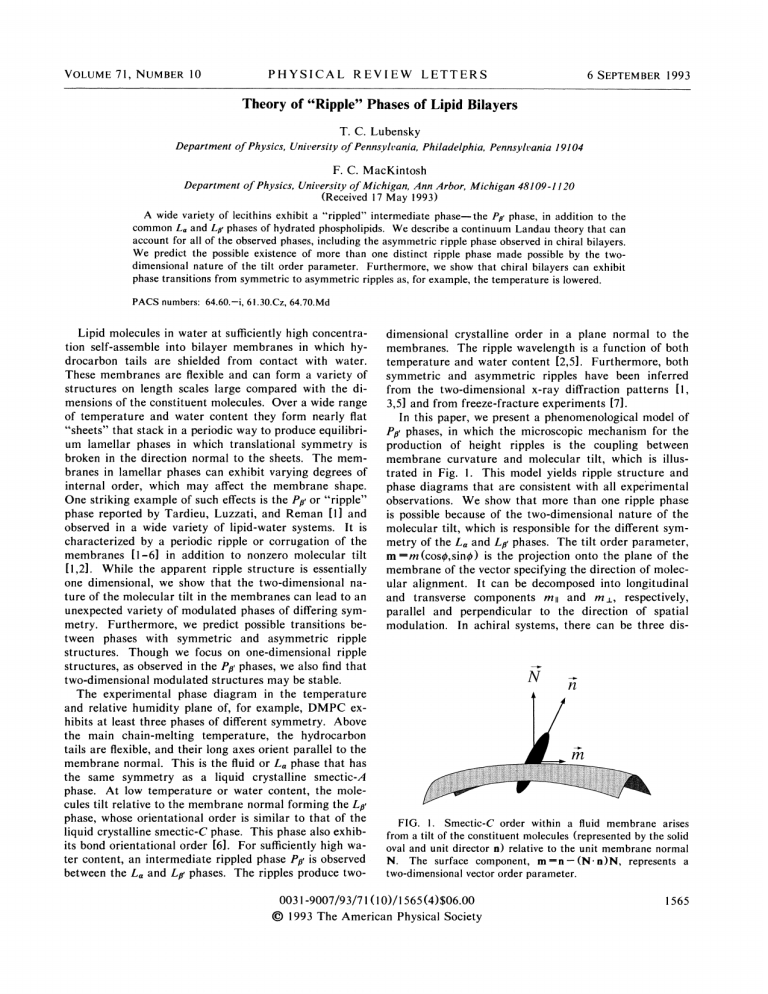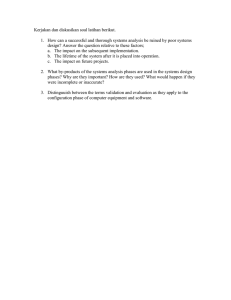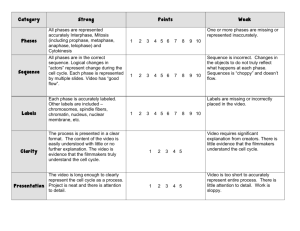LETTERS "Ripple" of YSICAL
advertisement

VOLUME 71, NUMBER 1 a PH YSICAL R EV I E%' LETTERS 6 SEPTEM BER 1993 Theory of "Ripple" Phases of Lipid Bilayers Department Department T. C. Lubensky of Pennsylvania, of Physics, Unt'versity of Physics, Philadelphia, Pennsylvania 19l04 F. C. MacKintosh of Michigan, Ann Arbor, Michigan 48I09 ll20(Received l7 May 1993) University — A wide variety of lecithins exhibit a "rippled" intermediate phase the P~ phase, in addition to the common L and Lp phases of hydrated phospholipids. We describe a continuum Landau theory that can account for all of the observed phases, including the asymmetric ripple phase observed in chiral bilayers. We predict the possible existence of more than one distinct ripple phase made possible by the twodimensional nature of the tilt order parameter. Furthermore, we show that chiral bilayers can exhibit phase transitions from symmetric to asymmetric ripples as, for example, the temperature is lowered. PACS numbers: 64.60.— i, 61.30.Cz, 64. 70.Md Lipid molecules in water at su%ciently high concentration self-assemble into bilayer membranes in which hydrocarbon tails are shielded from contact with water. These membranes are Aexible and can form a variety of structures on length scales large compared with the dimensions of the constituent molecules. Over a wide range of temperature and water content they form nearly Hat "sheets" that stack in a periodic way to produce equilibrium lamellar phases in which translational symmetry is broken in the direction normal to the sheets. The membranes in lamellar phases can exhibit varying degrees of internal order, which may aff'ect the membrane shape. One striking example of such efrects is the P~ or "ripple" phase reported by Tardieu, Luzzati, and Reman [1] and observed in a wide variety of lipid-water systems. It is characterized by a periodic ripple or corrugation of the membranes [1-6] in addition to nonzero molecular tilt [1,21. While the apparent ripple structure is essentially naone dimensional, we show that the two-dimensional ture of the molecular tilt in the membranes can lead to an unexpected variety of modulated phases of diA'ering symmetry. Furthermore, we predict possible transitions between phases with symmetric and asymmetric ripple structures. Though we focus on one-dimensional ripple structures, as observed in the Pp phases, we also find that two-dimensional modulated structures may be stable. The experimental phase diagram in the temperature and relative humidity plane of, for example, DMPC exhibits at least three phases of diA'erent symmetry. Above the main chain-melting the hydrocarbon temperature, tails are flexible, and their long axes orient parallel to the membrane normal. This is the Auid or L, phase that has the same symmetry as a liquid crystalline smectic-A phase. At low temperature or water content, the molecules tilt relative to the membrane normal forming the L~ phase, whose orientational order is similar to that of tke liquid crystalline smectic-C phase. This phase also exhibits bond orientational order [6]. For sufficiently high water content, an intermediate rippled phase Pp is observed between the L and L~ phases. The ripples produce two- dimensional crystalline order in a plane normal to the membranes. The ripple wavelength is a function of both temperature and water content [2,5]. Furthermore, both symmetric and asymmetric ripples have been inferred x-ray dilfraction patterns [1, from the two-dimensional 3,5] and from freeze-fracture experiments [7]. model of In this paper, we present a phenomenological Pp phases, in which the microscopic mechanism for the production of height ripples is the coupling between membrane curvature and molecular tilt, which is illustrated in Fig. 1. This model yields ripple structure and phase diagrams that are consistent with all experimental observations. We show that more than one ripple phase nature of the is possible because of the two-dimensional molecular tilt, which is responsible for the diAerent symmetry of the L and L~ phases. The tilt order parameter, m =m(cosp, sing) is the projection onto the plane of the membrane of the vector specifying the direction of molecIt can be decomposed into longitudinal ular alignment. m [t and m &, respectively, and transverse components to the direction of spatial parallel and perpendicular modulation. In achiral systems, there can be three dis- FIG. 1. Smectic-C order within a fluid membrane arises from a tilt of the constituent molecules (represented by the solid oval and unit director n) relative to the unit membrane normal N. The surface component, m n —(N n)N, represents a two-dimensional vector order parameter. 0031-9007/93/71 (10)/1565 (4) $06.00 1993 The American Physical Society 1565 VOLUME 71, NUMBER 10 PH YSICAL R EV I EW FIG. 2. A representation of the vector order parameter the symmetric (a) PP and (b) PP phases. m in tinct ripple phases, depicted in Fi~s. 2 and 3(a). We (i) (2) and PIj(3 . Each is charactershall call these P&, P&, ized by symmetric ripples; i.e. , ignoring molecular tilt, each membrane is symmetric under reflection through the midplane followed by a translation. The symmetric P&' and P& phases differ in that m& is nonzero in the Pp' phase. Thus, these two phases have different symmetry with respect to the molecular orientation even though they have the same symmetry with respect to membrane shape. The achiral P& phase is a spiral phase in which m makes one complete revolution in a spatial period. Each of these phases may occur in chiral systems, although the last of these becomes the asymmetric phase, PP*, which is shown in Fig. 3(a). In this case, the reflection symmetry of the membrane is broken. Two additional phases, Pit [depicted schematically in Fig. * 3(b)] and Pp may occur in chiral systems. The P& phase is an asymmetric rippled version of the stripe phase that occurs in chiral smectic-C films [8]. Finally, the * * phase is a period-doubled version of the P& Pfj phase. (A more complete description of the symmetries of these phases will be given elsewhere. ) Experiments most commonly report asymmetric ripples, though in some cases, the degree of asymmetry is very small suggesting that a true symmetric phase may exist. Recent experiments [91 also suggest that the Pp phase is characterized by transverse tilt in agreement with our results. In Ref. [10], mixtures of enantiomers of DPPC with opposite chirality were studied in excess water. A ripple phase was observed for all mixtures. Furthermore, no significant effect of mixing on the ripple wavelengths or the transition temperatures was observed phase would appear to be consistent with these obP& servations. However, we would expect that the degree of Alripple asymmetry would depend on the mixture. though asymmetric ripples were reported for the pure sys- *, LETTERS 6 SEPTEMBER 1993 FIG. 3. A representation of the vector order parameter * the asymmetric, chiral phases (a) PP* and (b) P& . tems, a systematic study of the ripple symmetry was not reported in Ref. [10]. Various models have been proposed that describe the bilayer ripple as a modulation in layer thickness [11—14]. However, x-ray diH'raction data [15] as well as the observed height amplitude (=25 A [4, 16]) are inconsistent with a modulation in layer thickness, as proposed by these theories. In contrast, the models of Doniach [171 and of Carlson and Sethna [18] are based on the microscopic packing properties of the lipid molecules. These models describe the ripple phase as one in which the membranes (of nearly constant thickness) undulate. While this picture is in better qualitative with known agreement structural properties of the ripple phase, these onedimensional models only account for molecular tilt in the direction of the ripple (i.e. , longitudinal tilt). Thus, they describe only phases similar to the symmetric P& phase of our theory. LanOur approach is to develop a phenomenological dau theory for tilt order and curvature of a single membrane [19]. We include the coupling of molecular tilt to membrane curvature that is ultimately responsible for the production of ripples. This coupling results from steric interactions between neighboring molecules, as illustrated in Fig. 4. A divergence of m corresponds to a varying tilt angle of the molecules relative to the surface, which gives rise to a spontaneous curvature of the membrane. This coupling of the tilt to curvature reduces the in-plane tilt elastic constant. Our model is similar to the Landau theory of smectic-A-to-smectic-C transitions in liquid crystals. The model free energy involves only quadratic and quartic terms that are allowed by rotational symmetry in the tangent phase: Our. 1566 m in f~ = p + + Ci(vxm) m) + ' t)m~ +u)m( C[[(V m) ' —, D(V 2 —, 71, NUMBER 10 VOLUME PH YSICAL R EVI EW 0 0 0 FIG. 4. An illustration of the microscopic origin of the coupling between tilt and curvature within a membrane. A divergence of the tilt m gives rise to a spontaneous curvature of the (b). membrane This is a Lifshitz [20] free energy that produces equilibrium modulated phases if Cii or C& is negative [in which case the (V m) term is needed for stability]. Because of the vector nature of the order parameter, no cubic term is allowed. The first terms represent the tilt elasticity in the tilted phase. To this we add the curvature energy, f, = ' —, «(V h) —y(V h)(V m), (2) including the coupling of gradients in tilt to the mean membrane curvature. Here, h(x, y) is the height of the membrane relative to some liat plane with coordinates (x,y), and V;Vih(x, y) is the curvature tensor. [Covariant forms of the terms in Eqs. (1) and (2) were shown in another context in Ref. [21].] When h is replaced by its equilibrium value in the presence of a nonvanishing V m, the result is an effective free energy identical to Eq. (1) but with a reduced longitudinal elastic constant, C(i=Cia —y /«. . When CIi &0, the equilibrium phases are spatially uniform; when Cii &0, modulated phases are possible with a characteristic wave number qn=(2x/X) = jiC(ii/2D that tends to zero at CIi =0. Thus, as the membrane rigidity is reduced (say, by increasing hydration), the L& phase becomes unstable to a ripple phase (P&) with decreasing wavelength. The critical point, with C~] =0, at which order first develops is a Lifshitz point. If only one dimensionally modulated phases are considered, then the mean-field ~hase diagram in Fig. 5 includes two rippled phases, P&' and in addition to the L and Lp phases. The spiral P& phase is stable in a region below the Lifshitz point as shown in Fig. 5. The transition between it and the P&' phase is first order. For the model defined in Eqs. (1) and (2), a phase with a square lattice modulation is the equilibrium phase in the region indicated by P& in Fig. 5. However, higher-order derivative terms not included above can Pj, LETTERS 6 SEPTEMBER 1993 FIG. 5. The mean-field phase diagram for one-dimensional ripple structures includes the symmetric ripple phases, P&' and (2) is lowered, there is a first-order tranP& . As the temperature sition from the P&' phase to the spiral P& phase. Near the Lifshitz point, a two-dimensional square lattice phase may be stable in the P~ region. sup~ress local Gaussian curvature. This can stabilize the P& phase away from the Lifshitz point. In chiral membranes, additional terms must be added to Eq. (1). The simplest chiral coupling [22] is e;k(V;Vjh)mjmk, where el is the antisymmetric tensor. The addition of this term converts the P& phase into the asymmetrical chiral PP phase depicted in Fi . 3(a). It does, however, affect the structure of the Pp' and Pg phases in this way. Chiral systems have also been shown to exhibit Oat striped phases, in which the molecular orientation m is spatially modulated [8,23, 24]. Together with both achiral, V hV m, and chiral, eI, (V;Vlh)mimk, couplings between h and m, such phases may become rippled. For example, chiral rippled phases can occur if we include hexatic order, which is known to be relevant for the observed Lp phases [6]. Hexatic order is described by an order parameter y = pie where 8 is the bond angle between nearest neighbor molecules. At low temperature, both of the order parameter amplitudes i@i and m are essentially constant, and the free energy depends only on the phases 8 and p, which have a preferred relative value. When the rigidity associated with 0 is much larger than that of P, the free energy [8,25] for a chiral mem+f„where brane is approximately i i ', f, =f f = f, = 2 ' —, C(V8 K(V8) )' —Vcos(-68 ), —X, (N Vxm)cos68- (3) . Here 8 —=8 —p and N is the unit normal to the membrane. The final term in is present only in chiral systems. This free energy, which does not yet include coupling to curvature, develops a Oat modulated minimum energy phase Mp* for sufficiently strong chiral coupling X, [8,23]. The couplings between h and m convert the Mp* f, 1567 VOLUME 71, NUMBER 10 PHYSICAL REVIEW LETTERS * phase. As membrane riphase into the asymmetric Pfj gidity is further reduced, a transition to the period* phase can occur. doubled P& We have not calculated a complete phase diagram showing all phases that can occur in chiral systems. Several observations can, however, be made. First, several distinct ripple phases are possible. These phases have diAerent symmetry with respect to the molecular tilt even though they may have the same symmetry with respect to membrane shape. Near the Lifshitz point, symmetric ripples are expected for both chiral and achiral systems. We also predict a square lattice modulation, such as has been observed in free standing thermotropic films [26]. At lower temperature and bending rigidity, however, a transition from a symmetric to an asymmetric ripple phase is expected in chira] systems. Various eAects, including intermembrane interactions and fluctuations can convert second-order transitions to first-order transitions in Fig. 5. These eA'ects can eliminate some phases altogether. Thus, for example, the experimental phase diagram for DMPC with a triple point where firstorder L,-Pp, L,-L~, and Lfj-P~ phase boundaries meet is not inconsistent with our theory. In general, however, we expect that more than one ripple phase should be observed. In particular, for chiral systems, we predict the existence of distinct symmetric and asymmetric ripple phases. T.C. L. acknowledges support from the NSF under Grants No. DMR-91-20668 and No. DMR 91-22645. F.C. M. acknowledges partial support from the Donors of the Petroleum Research Fund, administered by the American Chemical Society, and from the NSF under Grant No. DMR-9257544. Both authors are grateful for the hospitality of the Aspen Institute for Physics where a part of this work was carried out. The authors also wish to acknowledge helpful discussions with 3. Selinger and D. Mukamel. [I] A. Tardieu, V. Luzzati, and F. C. Reman, J. Mol. Biol. 75, 711 (1973). [2] M. J. Janiak, D. M. Small, and G. G. Shipley, Biochem. 15, 4575 (1976). [3] E. J. Luna and H. M. McConnell, Biochim. Biophys. Acta 466, 381 (1977). [4] J. A. N. Zasadzinski, J. Schneir, J. Gurley, V. Elings, and P. K. Hansma, Science 239, 1013 (1988). [5] D. C. Wack and W. W. Webb, Phys. Rev. Lett. 61, 1210 (1988). 1568 6 SEPTEMBER 1993 [6] E. B. Sirota, G. S. Smith, C. R. Safinya, R. J. Piano, and N. A. Clark, Science 242, 1406 (1988). [7] J. T. Woodward and J. A. N. Zasadzinski (unpublished). [8] S. A. Langer and J. P. Sethna, Phys. Rev. A 34, 5035 (1986); G. A. Hinshaw, R. Petschek, and R. A. Pelcovits, Phys. Rev. Lett. 60, 1864 (1988); G. A. Hinshaw, Jr. and R. Petschek, Phys. Rev. A 39, 5914 (1989). [9] M. P. Hentschel and F. Rustichelli, Phys. Rev. Lett. 66, 903 (1991). [10] J. A. N. Zasadzinski, Biochim. Biophys. Acta 946, 235 (1988). [11] M. S. Falkovitz, M. Seul, H. L. Frisch, and H. M. McConnell, Proc. Natl. Acad. Sci. 79, 3918 (1982). [12] M. Marder, H. L. Frisch, J. S. Langer, and H. M. McConnell, Proc. Natl. Acad. Sci. 81, 6559 (1984). [13] R. E. Goldstein and S. Leibler, Phys. Rev. Lett. 61, 2213 (1988). [14] Reference [13] also added interlayer interactions due to forces. However, the order parameter in these theories (Refs. [11—13]) is a scalar: the layer thickness. As noted by the authors of Ref. [13], this theory does not account for the diAerent symmetries of the L„L~,and P~ phases. [15] M. J. Janiak, D. M. Small, and G. G. Shipley, J. Biol. Chem. 254, 6068 (1979). [16] J. StamatoA', B. Feuer, J. Guggenheim, G. Tellez, and T. Yamane, Biophys. J. 3$, 217 (1982). [17] S. Doniach, J. Chem. Phys. 70, 4587 (1979). [18] J. M. Carlson and J. P. Sethna, Phys. Rev. A 36, 3359 van der %'aals and hydration (1987). [19] Recent experiments carried out on isolated membranes have shown these ripple structures as well [71. Thus it appears that interactions between layers are not required for the formation of the ripple base. [20] R. M. Hornreich, M. Luban, and S. Shtrickman, Phys. Rev. Lett. 35, 1678 (1975). [21] F. C. MacKintosh and T. C. Lubensky, Phys. Rev. Lett. 67, 1169 (1991). [22] W. Helfrich and J. Prost, Phys. Rev. A 38, 2065 (1988). [23] J. V. Selinger, in Complex Fluids, edited by E. B. Sirota, D. Weitz, T. Witten, and J. Israelachvilli (Material Research Society, Pittsburgh, 1992), p. 29; J. V. Selinger, Z. -G. Wang, R. F. Bruinsma, and C. M. Knobler, Phys. Rev. Lett. 70, 1139 (1993). [24] D. Blankschtein, E. Domany, and R. M. Hornreich, Phys. Rev. Lett. 49, 1716 (1982); J. Felix, D. Mukamel, and R. M. Hornreich, Phys. Rev. Lett. 57, 2180 (1986); A. E. Jacobs, G. Goldner, and D. Mukamel, Phys. Rev. A 45, 5783 (1992). [25] J. V. Seinger and D. R. Nelson, Phys. Rev. A 39, 3135 (1989). [26] E. B. Sirota, P. S. Pershan, and M. Deutsch, Phys. Rev. A 36, 2902 (1987).






